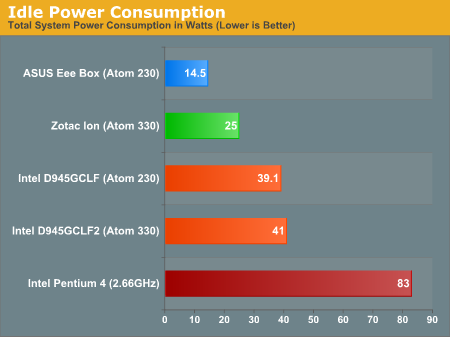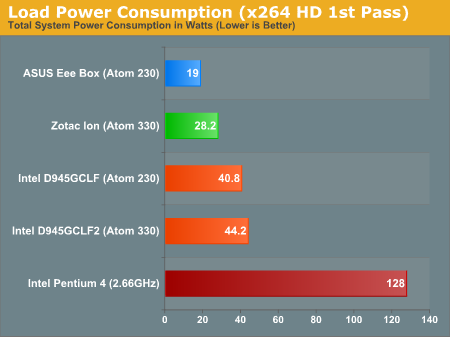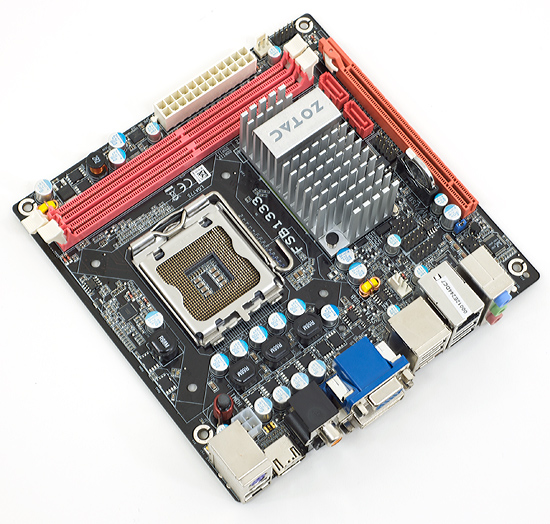Zotac's Ion: The World's First mini-ITX Ion Board
by Anand Lal Shimpi on May 12, 2009 12:00 AM EST- Posted in
- GPUs
Power Consumption
Compared to the Intel Atom boards, the Zotac wins out - it doesn't have to use a bulky desktop power supply which isn't as efficient at these low power draws. Compared to something more similar however, like the Atom 230 based ASUS Eee Box with its own external DC power supply, we see that the Zotac Ion does draw more power than Intel's Atom platform. I'm not sure how much more this could be cut down when used in a netbook/notebook, but that could be a deal breaker for more mobile versions of Ion.


Final Words
What do I think of the world's first mini-ITX Atom Ion motherboard? I like it. Zotac did a good job of delivering pretty much everything I'd want in a board like this, going even further than expected and offering a solution with an external power brick. I don't like the external power option from a long-term replacement standpoint, but I do appreciate its convenience. My only complaint is the price, at $189 it's a bit expensive for the performance you get but I do concede that there are some benefits in the convenience department. All you need to add is memory and some sort of storage and you're good to go, you'll have a system that's easily capable of playing back high definition content (not to mention very power efficient while doing it).
The general application performance of the Zotac Ion isn’t actually any better than the Intel D945GCLF2. It’s when you look at GPU-enabled applications that the Ion holds any real performance benefit. Blu-ray playback or 3D gaming are its real performance strengths; if you plan on doing neither then the platform isn’t very useful.
I did try some CUDA applications on the Zotac Ion board and they were definitely faster than using the CPU alone. While our x264 test managed around 12 fps on the Zotac Ion, using Badaboom I was able to encode at just under 20 fps.
When it comes to the Atom processor, at least on the desktop, there’s simply no reason to opt for the single-core model. Most tasks are so completely CPU bound on Atom that any increase in processing power is instantly noticeable. The Atom 330 ends up being faster than even a 1.6GHz single-core Celeron 420 in many tests, particularly video encoding and 3D rendering, while falling behind in other applications like WinRAR and even our general SYSMark tests. With enough cores, the Atom architecture is efficient in delivering good floating point performance it seems. Branchy integer code however favors the speculative execution engines of more conventional desktop microprocessors. The only reason I see the single-core Atom being of any use is if you're building a cheap file server, but otherwise the Atom 330 is so much faster across the board that it's more than worth it. Hyper-Threading definitely helps the Atom 230, but there's no replacement for another fully functional core. The added power consumption is nothing serious.
If you do need more CPU power, Zotac actually offers an LGA-775 version of the board but it of course requires a standard power supply:

Power consumption on the Zotac Ion is appreciably low, thanks in part to its 90W DC power supply. Compared to ASUS’ Eee Box however, the Ion system does use nearly 50% more power under load.
Everyone seemed to want an Ion based motherboard after NVIDIA first showed off its reference platform. Acer delivered the first Ion system, but it looks like Zotac is delivering what we all wanted from the start. Now it's time to see how people start using these things....










93 Comments
View All Comments
ahmshaegar - Tuesday, May 12, 2009 - link
Greater power consumption = more heat. Where's that energy going to go?marshylucas - Tuesday, May 12, 2009 - link
You were faster, I was about to reply something similar.Thumbs up for the fanless design!
Jeffk464 - Tuesday, May 12, 2009 - link
Yes, but my laptop is very quiet, even with being severely limited on space for a heat sink and fan. If you had more rooms to put a large heat sink on it with a large low rpm fan, I think it would be near silent.trabpukcip - Friday, May 15, 2009 - link
A laptop does not make the best HTPC though. Connectivity is too limited and is generally inconvenient.GeorgeH - Tuesday, May 12, 2009 - link
"a single Gigabit Ethernet port (just like on the Intel boards)"Actually, only the D945GCLF2 has Gigabit Ethernet. The D945GCLF is stuck with 10/100, which is kind of a deal killer for me.
Anand Lal Shimpi - Tuesday, May 12, 2009 - link
Thanks for the correction :)Take care,
Anand
DrLudvig - Tuesday, May 12, 2009 - link
I'm confused here, most places it says that the hole ION thing is a 9400 chip, while some other places, like now here, says 9300?What is it really?
Anand Lal Shimpi - Tuesday, May 12, 2009 - link
The 9300 and 9400 are the same chip, the difference is GPU clock. Take a look at the table on this page:http://www.anandtech.com/mb/showdoc.aspx?i=3432">http://www.anandtech.com/mb/showdoc.aspx?i=3432
The GF9300 on the Zotac board actually runs a bit slower than the stock GeForce 9300. It runs its core at 450MHz and its shaders at 1.1GHz instead of 450/1.2.
Take care,
Anand
Badkarma - Tuesday, May 12, 2009 - link
Anand,Can you please confirm/deny if the Zotac Ion boards support wake-on-usb? The Zotac 9300 mini-itx board does not support wake-on-usb and therefore powering the system on from standby from the MCE remote does not work without physical workarounds.
Thanks.
Anand Lal Shimpi - Tuesday, May 12, 2009 - link
I'm out of the office right now but I'll try it this weekend :) Drop me an email to remind me if you don't see something by the end of next week :)Take care,
Anand